Having a safety policy is one of the legal requirements for most businesses. Even if that legal document is not mandatory in your case, it is always good to have it. A safety policy will help you manage all the safety and health procedures.
Safe working conditions inspire employees to work hard and keep the same level of productivity for a long period. It will also help you keep your reputation and attract new professionals that can boost the productiveness of the entire company.
Unfortunately, writing a safety policy is not an easy task. You will need to determine the purpose and capabilities of the business before you start writing. After figuring out the potential safety challenges in the workplace. You can cover all the safety gaps in your safety policy.
Every safety policy contains three different parts
-
Statement of Intent
-
The Organization of Health and Safety
-
Health and Safety Arrangements
Each section requires an in-depth analysis that you can check out below on how to write a safety policy that engages your employees.
Statement of Intent
In the first section of the safety policy, you will have to describe how your organization plans to manage all the safety issues. The methods you plan to use need to be compatible with the law requirements. That is the reason why you need to clearly describe objectives as well as safety aims.
Objectives are usually measurable goals that a company wants to reach. For instance, training 90% of all employees, and reducing the distribution of high risk by 20% are good objectives. Safety aims are, on the other hand, all the goals that are unmeasurable.
Stay realistic and clear and cover the tiniest details that will boost the quality of the policy. For instance, saying something like "The company will do everything to prevent all the accidents" is not enough. You can say that the equipment and tools employees use meet all the safety standards or talk about training that all employees will have to pass. If that seems like a challenging process, you can use some online writing services like GetGoodGrade to complete the job instead of you.
However, even experts won't manage to help if you don't tell them what exactly the statement of intent should contain. You will need to identify all the principal hazards to employees and clearly explain how you plan to control the potential risk. Despite that, make sure you are familiar with all basic law requirements. Depending on your country, you may need to highlight the type of equipment employees will work with, all the safety systems the company is using, etc.
Before ending this section, there is one more thing you will need to have in mind. Every statement of intent also describes safety performance targets. The performance targets confirm the commitment of the entire management to improve all the safety performances regularly. That will serve as an inspiration for all the employees that work in your company.
Some of the safety aims that you can include here are reduction in civil claims, reduction in all accidents at work, reduction in sickness absences, etc. The example below may serve as an inspiration for people that struggle to write a statement of intent properly.
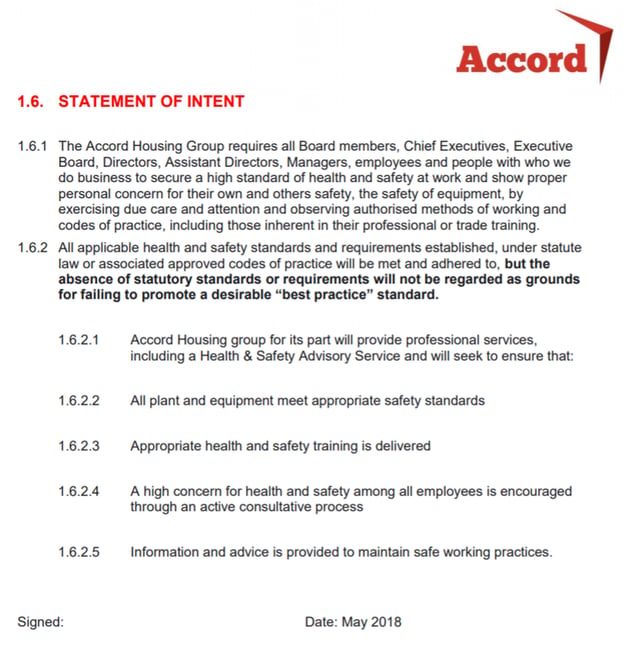
Source: Accordgroup
The Organization of Health and Safety
This section highlights all the responsible individuals/positions/groups within the company that need to ensure safe work conditions. Usage of the organizational chart may be the best possible way to present the hierarchy of all the employees that have some role in safety procedures.
The way how you will present that chart depends on the size of the company. For instance, if you are a small business owner, a simple list will be enough. After you mark the position responsible for specific safety procedures, you need to explain which task they exactly have. The examples below are a good way to do that.
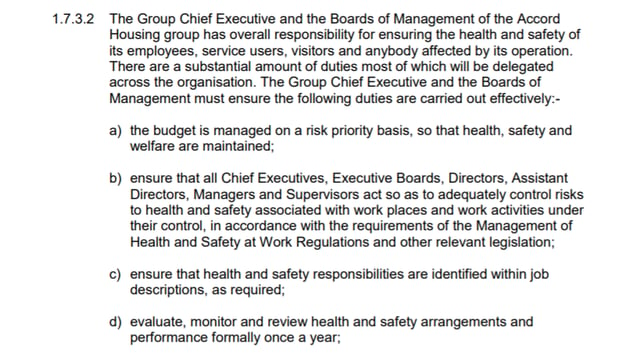
Source: Accordgroup
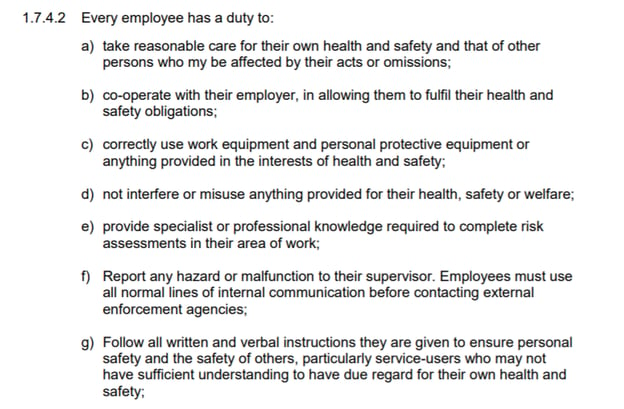
Source: Accordgroup
As you can see, the purpose of the organization of health and safety is to clearly explain the duties that every individual has within the organization. Be precise, but set some limits at the same time. It would be enough to highlight the positions and responsibilities related to safety procedures. Everything more than that would be unnecessary.
This part is especially important for employees. You will clearly explain to them that the company ensured all appropriate work conditions. However, workers will also need to respect the safety rules on their own to keep their own safety and the safety of their co-workers.
Health and Safety Arrangements
This is the longest part of the safety policy that describes methods that will control the risks workers and other participants experience every day within the company. Sharing details about all the security systems here would be the right choice.
Describing safety procedures is not always going to be easy. For instance, arrangements are different for fire, water, and any other type of emergencies. You should provide all the information, training, and instructions in this section. You can check out the image below to make the health and safety arrangement section more eye-pleasing.
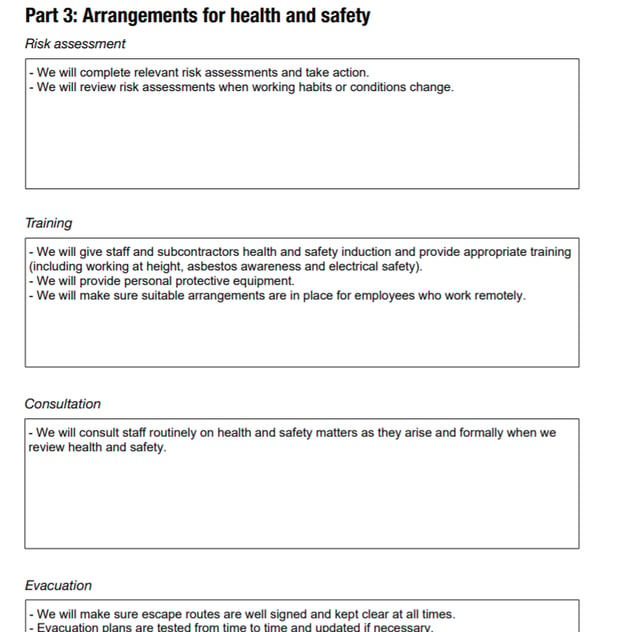
Source: Safeti.com
Bonus Tip: Keep It Simple
The safety policy needs to be simple and clear to every employee. Tables, bullet lists, and subheadings are a great way to make it informative and eye-pleasing. Try to keep your writing style professional but simple. Employers often struggle to write content that is informative, engaging and at the same time brief. If that’s your case, online writing services that write different academic papers can be a good alternative. Professional writers will know how to simplify the content, and you can be sure your employees will understand all the duties and instructions.
Final Thought
Now you know how to make the safety policy clear and effective. Fulfill each section with all the necessary details, use the appropriate language to make everything clear — and you will ensure safety standards that all employees will gladly accept. Remember, that a high salary won't always help you attract professionals. On the other hand, good working conditions and safety standards will surely boost the reputation of your company.
Author’s Bio: Jessica Fender is a professional writer and educational blogger. Jessica enjoys sharing her ideas to make writing and learning fun.





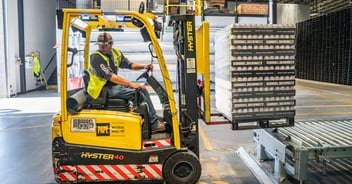
Leave a Comment